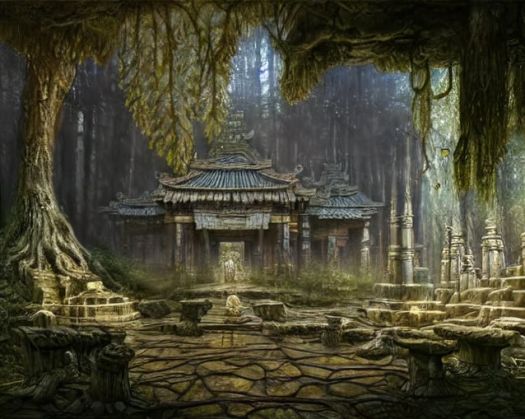Difference between revisions of "Hallucinatory Terrain (spell)"
Tao alexis (talk | contribs) |
Tao alexis (talk | contribs) |
||
| Line 1: | Line 1: | ||
| − | [[File:Hallucinatory Terrain (spell).jpg|right| | + | [[File:Hallucinatory Terrain (spell).jpg|right|525px|thumb]] |
'''Hallucinatory Terrain''' is an spell that allows an illusionary alteration to the appearance of an existing terrain, so that rocks, vegetation, the lay of the land or the presence of water bodies can be created or removed from the onlooker's perception. Whatever's meant to appear — grass, living trees, lush jungle, swamp and so on, even the aspect of natural fruits or other foods, will seem to be perfectly real, even to where they can be "picked" from the tree. Buildings and other constructions can also be made to appear. | '''Hallucinatory Terrain''' is an spell that allows an illusionary alteration to the appearance of an existing terrain, so that rocks, vegetation, the lay of the land or the presence of water bodies can be created or removed from the onlooker's perception. Whatever's meant to appear — grass, living trees, lush jungle, swamp and so on, even the aspect of natural fruits or other foods, will seem to be perfectly real, even to where they can be "picked" from the tree. Buildings and other constructions can also be made to appear. | ||
Revision as of 18:40, 2 October 2023
Hallucinatory Terrain is an spell that allows an illusionary alteration to the appearance of an existing terrain, so that rocks, vegetation, the lay of the land or the presence of water bodies can be created or removed from the onlooker's perception. Whatever's meant to appear — grass, living trees, lush jungle, swamp and so on, even the aspect of natural fruits or other foods, will seem to be perfectly real, even to where they can be "picked" from the tree. Buildings and other constructions can also be made to appear.
| Range | 40 ft. per level |
| Duration | 25 rounds per level |
| Area of Effect | 20 ft. diameter cube per level |
| Casting Time | 2 rounds |
| Saving Throw | none; see text |
| Level | illusionist (3rd) |
Likewise, observers experience the unreal terrain as it's meant to feel: one can swim in the pond that's created, or climb into crevices or caves, or upon rocks, or step off a cliff while believing they're walking across even ground. This is because even if the terrain "feels" right, it isn't real. Found edibles don't provide sustenance and illusionary water can't make the observer wet. Any "effect" is actually only in the mind of the witnessing character.
Saving Throws
Before an observer can actually come to harm, however, he or she is allowed a saving throw. A success won't reveal the illusion, but it will cause the character interacting with the terrain will just "decide" to go somewhere else, or get interested in something else, and thus not walk off the cliff. A successful save may also suggest that the visible bridge is unsafe, that it won't actually support the character's weight and so on.
Limitations
The spell cannot create living creatures using the spell, nor can it blot out the existence of these creatures. Thus, denizens are visible inasmuch as they can be seen behind the hallucinatory terrain's features; moving left or right would reveal such behind a tree, for instance.
If the observer knows the terrain is inaccurate, because they are well familiar with the area, then a saving throw is allowed — the success of which would confirm the observer's suspicion that the terrain is false (though it's appearance is unchanged by this revelation). A detect illusion spell reveals the real terrain, causing the hallucinatory terrain to become a transparent visage that can be seen through.
Paradoxes
Equally true, creatures who ‘fall’ or ‘drown’ or otherwise might injure themselves in an hallucinatory terrain (one attempts to hang himself from a tree, for instance) are also entitled to a saving throw. In the case of possible death, a fail indicates that they suffer 2d6 per their own level in damage; if in a case where death was very unlikely to occur, a failed save would result in only 2d4 damage.
In either case, a saving throw would then permit the viewer to "see" the illusion for what it was … a failed save would mean the viewer is yet affected by the terrain as would any unknowing creature be.
The actions of others, believing or not, will always be interpreted by unaware creatures within the framework of the illusion. Thus, the illusionist walking through a pond—for the illusionist is always immune to their own illusion—would be seen as swimming across it, while a creature moving through an overgrown area would appear to be fighting the trees, and so on. The spell will also cause such movement to be regular and believable. A creature crossing a 20 feet area with a 100 feet rock spire in it would appear to be climbing the spire for the expected time required—for passage of time in the mind of the affected viewer is also altered. Thus, though only a round might pass, for the viewer is may seem like 20 minutes—if the illusion of reality demands that it must have been so.
This will occasionally create some difficulties in interpreting what happens when and how, which the DM must be prepared to reconcile.
